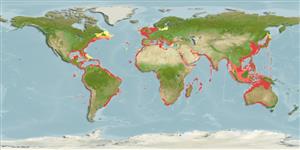Common names from other countries
Classification / Names / Names
Namen | Synonyme | Catalog of Fishes (gen., sp.) | ITIS | CoL | WoRMS
Environment: milieu / climate zone / depth range / distribution range
Ökologie
Riff-verbunden; ozeanodrom (Ref. 75927); tiefenbereich 0 - 347 m (Ref. 417), usually 0 - 100 m (Ref. 1977). Tropical; ? - 7°C (Ref. 275), preferred 26°C (Ref. 107945); 57°N - 38°S, 98°W - 146°E (Ref. 275)
Circumglobal in temperate and tropical seas.
Length at first maturity / Size / Gewicht / Alter
Maturity: Lm ?, range 8 - 11.3 cm Max length : 180 cm TL Männchen/unbestimmt; (Ref. 104052); 120 cm TL (female); max. veröff. Gewicht: 10.0 kg (Ref. 275)
Maximum common depth is 150 m in Ref. 75927. Maximum depth range from Ref. 114857. Maximum length for female from Ref. 804. This octopus is taken by amateur fishers and in small to large-scale harvest throughout its range. The greatest fishery effort occurs off northwest Africa, and it is know as one of the most valuable octopod species throughout the Mediterranean Sea where it is marketed fresh or frozen (Ref. 96968). Inhabits rocky, sandy and muddy bottoms of the coastline to the edge of the continental shelf (Ref. 2133). Found in intertidal and subtidal areas (Ref. 83938).
Members of the class Cephalopoda are gonochoric. Male and female adults usually die shortly after spawning and brooding, respectively. Mating behavior: Males perform various displays to attract potential females for copulation. During copulation, male grasp the female and inserts the hectocotylus into the female's mantle cavity where fertilization usually occurs. Life cycle: Embryos hatch into planktonic stage and live for some time before they grow larger and take up a benthic existence as adults.
Roper, C.F.E., M.J. Sweeney and C.E. Nauen. 1984. (Ref. 275)
IUCN Rote Liste Status (Ref. 130435)
CITES Status (Ref. 108899)
Not Evaluated
Not Evaluated
Nutzung durch Menschen
Fischereien: kommerziell
FAO - Fischereien: landings, Artbeschreibung | FIRMS (Stock assessments) | FishSource | Sea Around Us
Tools
Internet Quellen
Estimates based on models
Preferred temperature
(Ref.
115969): 10 - 28.9, mean 25.8 (based on 8514 cells).
Widerstandsfähigkeit
hoch, Verdopplung der Population dauert weniger als 15 Monate. (K=0.38-0.72; tm=1.2).
Prior r = 0.77, 95% CL = 0.51 - 1.15, Based on 4 full stock assessments.
Verwundbarkeit
Very high vulnerability (78 of 100).
